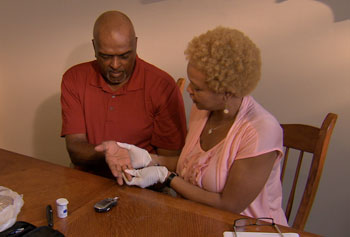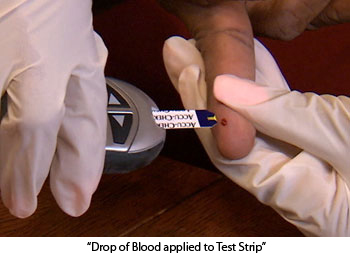Introduction to Measuring Blood Sugar (Glucose monitoring)

When you provide care for a person who has Diabetes mellitus you need to know how to measure their blood sugar (called blood glucose). The person’s blood glucose is a measure of their health.
- Glucose is a simple sugar found in many foods. When it enters the bloodstream it provides energy for the body.
- The cells of our body use glucose for normal metabolism.
- Normally, glucose enters cells with the help of insulin.
- Persons with diabetes either do not make enough insulin or are “insulin resistant” meaning they make insulin but it does not work properly.
Measuring blood glucose helps a person with diabetes manage their disease. The level of a person’s blood glucose determines:
- The diabetes medicines they should take
- The type and amount of food they can eat
- The level of exercise they can take part in.

Measuring blood glucose requires a very simple blood test. You place a test strip into a small glucose meter. Then you prick the person’s finger with a sterile lancet and squeeze a small drop of blood onto the test strip. In a few seconds the meter displays the amount of glucose in the blood. The person’s doctor will tell you how often the person should check their blood glucose.
Learn how to measure a person’s blood glucose in case he or she becomes ill or has trouble handling the test meter or lancet.
Safe blood glucose monitoring requires you to:
- Know the normal range for a blood glucose level
- Know what to do when a person’s blood glucose is too low or too high
- Obtain a blood drop without causing the person to get an infection
- Protect yourself from a lancet stick.
Here is Marita’s story:

My husband Miguel has had diabetes for 10 years. He takes insulin every day and checks his blood glucose four times a day to see how well he is in control. His doctor wants him to check his blood glucose before meals and sometimes at bedtime. Miguel needs to keep his blood glucose level between 70 - 150. There are times when Miguel has needed me to measure his blood glucose for him. Just last year he broke his right arm after a fall and he could not hold the lancet to stick his finger. I have found that it is really easy to check his blood glucose for him. The hardest part is making sure I can get a good size blood drop to put on the test strip. Miguel is used to having his finger stuck, and he tells me that it isn’t painful. I know that it’s really important that Miguel monitor his blood glucose so that he can manage his diabetes better.